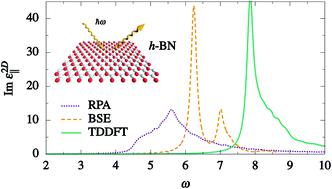当前位置:
X-MOL 学术
›
Faraday Discuss.
›
论文详情
Our official English website, www.x-mol.net, welcomes your
feedback! (Note: you will need to create a separate account there.)
Optical spectra of 2D monolayers from time-dependent density functional theory.
Faraday Discussions ( IF 3.3 ) Pub Date : 2020-07-06 , DOI: 10.1039/d0fd00073f S Di Sabatino 1 , J A Berger , P Romaniello
Faraday Discussions ( IF 3.3 ) Pub Date : 2020-07-06 , DOI: 10.1039/d0fd00073f S Di Sabatino 1 , J A Berger , P Romaniello
Affiliation

|
The optical spectra of two-dimensional (2D) periodic systems provide a challenge for time-dependent density-functional theory (TDDFT) because of the large excitonic effects in these materials. In this work we explore how accurately these spectra can be described within a pure Kohn–Sham time-dependent density-functional framework, i.e., a framework in which no theory beyond Kohn–Sham density-functional theory, such as GW, is required to correct the Kohn–Sham gap. To achieve this goal we adapted a recent approach we developed for the optical spectra of 3D systems [S. Cavo, J. A. Berger and P. Romaniello, Phys. Rev. B, 2020, 101, 115109] to those of 2D systems. Our approach relies on the link between the exchange–correlation kernel of TDDFT and the derivative discontinuity of ground-state density-functional theory, which guarantees a correct quasi-particle gap, and on a generalization of the polarization functional [J. A. Berger, Phys. Rev. Lett., 2015, 115, 137402], which describes the excitonic effects. We applied our approach to two prototypical 2D monolayers, h-BN and MoS2. We find that our protocol gives a qualitatively good description of the optical spectrum of h-BN, whereas improvements are needed for MoS2 to describe the intensity of the excitonic peaks.
中文翻译:

基于时变密度泛函理论的二维单层光谱。
二维(2D)周期系统的光谱为依赖于时间的密度泛函理论(TDDFT)提出了挑战,因为这些材料中的激子效应很大。在这项工作中,我们探索如何在纯的Kohn-Sham随时间变化的密度函数框架内准确描述这些光谱,即在该框架中不需要超出Kohn-Sham密度函数理论的任何理论,例如GW,纠正Kohn-Sham差距。为了实现这一目标,我们采用了针对3D系统光谱开发的最新方法[S. Cavo,JA Berger和P.Romaniello,物理学。版本B,2020年,101(115109)适用于2D系统。我们的方法依赖于TDDFT的交换相关核与基态密度泛函理论的导数不连续性之间的联系,后者保证了正确的准粒子间隙,并且依赖于极化泛函的泛化[JA Berger,Phys。牧师 ,2015,115,137402],其描述了激子的效果。我们将我们的方法应用于两个典型的2D单层,即h-BN和MoS 2。我们发现我们的协议在质量上很好地描述了h-BN的光谱,而MoS 2需要改进来描述激子峰的强度。
更新日期:2020-07-06
中文翻译:

基于时变密度泛函理论的二维单层光谱。
二维(2D)周期系统的光谱为依赖于时间的密度泛函理论(TDDFT)提出了挑战,因为这些材料中的激子效应很大。在这项工作中,我们探索如何在纯的Kohn-Sham随时间变化的密度函数框架内准确描述这些光谱,即在该框架中不需要超出Kohn-Sham密度函数理论的任何理论,例如GW,纠正Kohn-Sham差距。为了实现这一目标,我们采用了针对3D系统光谱开发的最新方法[S. Cavo,JA Berger和P.Romaniello,物理学。版本B,2020年,101(115109)适用于2D系统。我们的方法依赖于TDDFT的交换相关核与基态密度泛函理论的导数不连续性之间的联系,后者保证了正确的准粒子间隙,并且依赖于极化泛函的泛化[JA Berger,Phys。牧师 ,2015,115,137402],其描述了激子的效果。我们将我们的方法应用于两个典型的2D单层,即h-BN和MoS 2。我们发现我们的协议在质量上很好地描述了h-BN的光谱,而MoS 2需要改进来描述激子峰的强度。











































 京公网安备 11010802027423号
京公网安备 11010802027423号